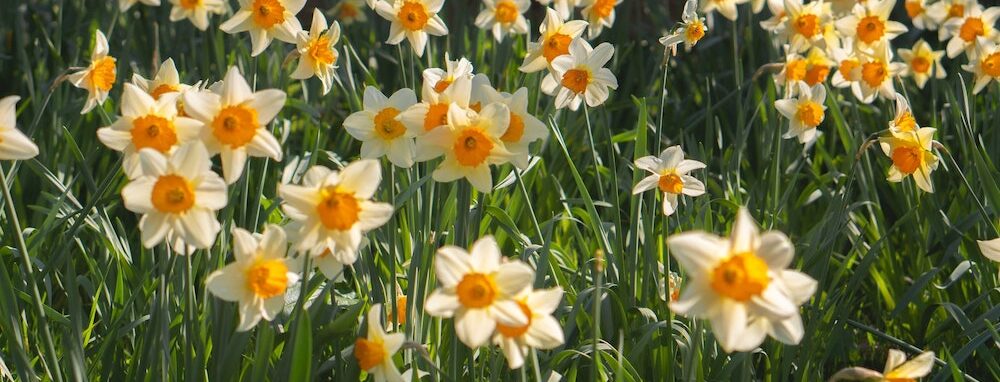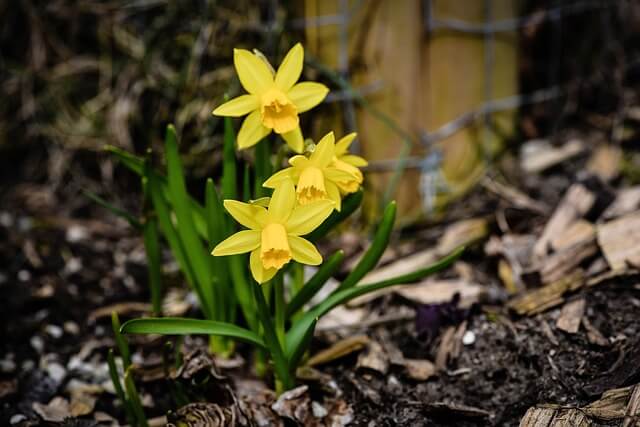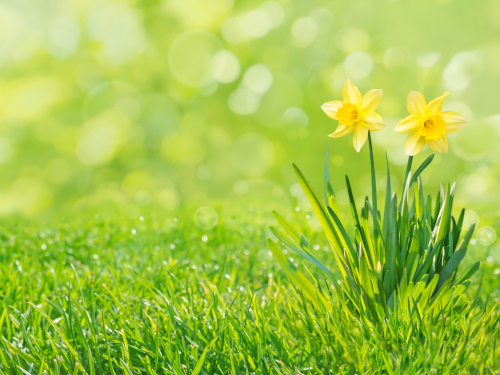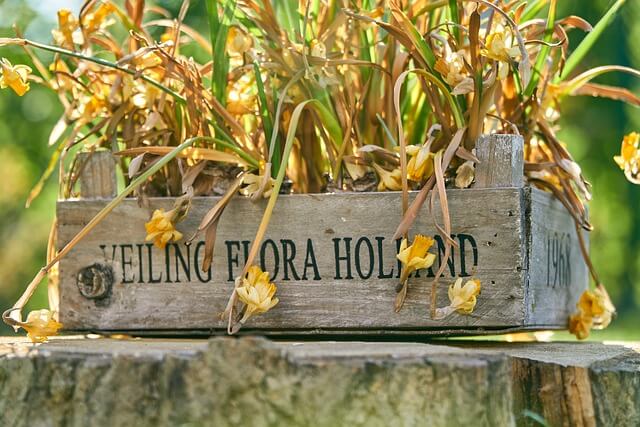Log in or create new account to save this product to your wishlist.

How and When to Plant Daffodil Bulbs
Daffodils are lovely, cheerful plants whose flowers are often the first indication of the coming of spring. And while they're simple to plant and look after, it's important to understand their needs. Find out here!
🌱 All important maintenance moments for your lawn during the year. Leave your email and we will send you the lawn calendar for free.
Enter your email
Receive the lawn calendar in the mail
Enjoy a green lawn all year round!

- Order by 2PM = shipped today
- 250.000+ satisfied customers!
- 60 day satisfaction guarantee
OK. At the time of publishing (August 2023), you’re probably thinking more about how to get the most out of your summer garden than the flowers that appear in spring. But, actually, September is the optimal time to plant daffodil bulbs.
- What are daffodils?
- Types of daffodil
- When to plant daffodil bulbs?
- Where to plant daffodil bulbs?
- How deep do you plant daffodil bulbs?
- How far apart should you plant daffodil bulbs?
- How to plant daffodil bulbs: A step-by-step plan
- How to care for daffodils
- My favourite daffodil varieties
- What to do with faded daffodils
- FAQs
Daffodils: those sunny, cheerful blooms that brighten up a dull, wintered garden, indicating the turn of spring. And while their blooms last just a short time, their brief appearance transforms your faded winter garden into something altogether more cheerful.
With a handy step-by-step guide, this article explores how and when to plant daffodil bulbs.
Ready? Let’s go!
What are daffodils?

The botanical name for the common-or-garden daffodil is “narcissus”, and these beautiful plants introduce a welcome touch of happiness to an overwintered garden.
Daffs are hardy plants resistant to frost and cold temperatures, meaning that a single bulb will give you many years of springtime happiness.
These jolly plants grow in early spring, although some species are later bloomers, bursting into flower as late as May. But once they’ve flowered, you’ll find a community of pollinators, such as butterflies and bees, all around your garden.
And who doesn’t want that?
Types of daffodil

There are many different varieties of narcissus, each with unique characteristics and flowering windows:
- Early bloomers, flowering in February and March
- Late bloomers, which burst into flower in May
For the best display of daffodils, I recommend planting several varieties so that you can enjoy that bright yellow bloom in your garden for longer.
Additionally, you can differentiate between narcissus varieties by the shape and size of the flower. The traditional daff has that classic trumpet shape around the stamen, while other types include the double daffodil and the small-flowered variety.
Double daffodil
The double daffodil (Narcissus pseudonarcissus anglicus flore pleno) has a central petal cluster rather than a trumpet, often accompanied by ruffles and colourful tufts of splaying petals and leaves.
Dwarf daffodils
Dwarf daffodils grow to less than 35cm in height, with tiny trumpet heads — perform for borders and pots.
When to plant daffodil bulbs?

The optimal time to plant daffodil bulbs is in autumn before the soil freezes. This gives the bulb enough time to take root before the onset of winter.
In general, the ideal time is September to November — don’t be tempted to plant them too early; new bulbs can rot in the ground if there’s a lot of summer rain.
It’s also possible to plant daffodil bulbs a little later than November — as long as the soil isn’t frozen. But these bulbs are unlikely to flower in the following spring.
The ideal soil temperature for planting daffodil bulbs is between 0ºC and 9ºC. Never plant below 0ºC because the bulb needs to have developed roots before exposure to frost.
Where to plant daffodil bulbs?
Choose a sunny spot with moist, well-draining soil. If you have heavy clay soil, enrich the planting hole with organic matter, such as compost, to improve drainage.
Daffodils in pots
Of course, daffodils often do as well in pots as in the ground, making them a great addition to a springtime patio. Use a peat-free potting soil, and place the pot in full sun.
Remember, if daffodils are happy in their position, they’ll multiply over time — like garlic bulbs, frost triggers bulb division.
While you’ll be happy for your daffs to spread across your garden, you’ll find that daffs in pots can get a little crowded. So, replace the potting soil and thin out the bulbs every few years.
Daffodils in your lawn

Some people plant daffodils directly into their lawns, proffering a cottage feel to a garden. Use a bulb planter to remove the soil, which can be replaced after planting the bulb.
How deep do you plant daffodil bulbs?
The general rule of thumb with bulb planting is to plant it double the depth of the bulb’s height.
So, if your bulb is 5cm tall from root to tip, plant it 10cm into the soil.
Always plant the bulb with the tip facing upwards and the root downwards.
How far apart should you plant daffodil bulbs?
Bearing in mind the spreading tendency of daffodils, it’s wise to leave at least 10-15cm between each bulb when planting. This provides plenty of space for roots to develop, but it also includes room for the plant to bloom.
How to plant daffodil bulbs: A step-by-step plan
Planting daffs is one of the more straightforward gardening tasks. However, here’s a handy check-list to ensure you get the best results:
1. Prepare the soil
Loosen the soil with a spade or gardening fork, removing stones or compacted earth. Mix a little grit or compost into the surrounding soil if it’s compacted or heavy clay — this will assist drainage, preventing bulb rot.
2. Dig the holes
Remember, keep the bulbs 10-15cm apart, and dig a hole twice as deep as the bulb’s height.
3. Plant the bulbs
Plant each bulb root-side down, and then cover with earth. Don’t press the soil too hard — you want oxygen to reach the bulb.
4. Water
Your bulbs will take root more quickly if you water them immediately after planting.
How to care for daffodils
It’s typically straightforward to maintain a daffodil plant. However, use this troubleshooting guide to determine why a daffodil isn’t thriving:
- Daffodils failing to flower — check the soil’s drainage; the bulb could be slowly rotting.
- Daffodil flowers dying off quickly — ensure your daffs are getting enough water. Typically, they need 1cm of water each week.
My favourite daffodil varieties
- Narcissus Jetfire — March/April flowering, with lovely yellow petals and an orange trumpet. Height & spread, 20x10cm
- Rijnveld’s Early Sensation — flowers in December in south-facing sunny spots, as long as it’s sheltered. A stunning variety with large, windmill-style flowers. H&S — 35x20cm
- Minnow — produces clusters of “cup-and-saucer” blooms in March and April. White petals surrounding a yellow trumpet and a sweet fragrance. Needs full sun. H&S — 20x10cm
- Spellbinder — the classic daffodil with yellow petals and a yellow trumpet, which fades to white over time. Flowers in March or April. H&S — 50x10cm
What to do with faded daffodils

Avoid cutting the foliage back immediately after the blooms have faded — this is an essential period for the plant, as it continues to extract nutrients from the soil and the sun.
Once the foliage has turned yellow, cutting it back to the ground is OK. There’s no need to lift the bulbs — just leave them there for next year.
FAQs
Plant your daffodil bulbs between September and November before the soil has frozen. Dig a hole that’s twice as deep as the bulb’s height (from root to tip). Plant it root-side down and cover it loosely with soil. Then, water immediately.
Daffodils are pretty versatile — you can plant them in pots, flowerbeds, or even directly into your lawn. They need good sun exposure and well-draining, moist soil.
Yes. Leave your daffodil bulbs in the ground after flowering. They’ll come back next spring. However, don’t be tempted to cut the leaves back as soon as the flower has faded — wait until the leaves have turned yellow before cutting them back to the soil.
Any questions?
I hope you have all the answers you need to enjoy beautiful, abundant daffodils in your garden. But if you have questions, don’t hesitate to email us.
Or check out our Help & Advice section — for all your garden and lawn care questions!
Thanks for reading. And happy gardening.
-
Orchids: A Complete Guide on How to Care for ThemWant to give your orchid the best possible care? Discover essential tips from placement to watering and pruning. Learn everything you need to know!Read more
-
Growing Wisteria Made Simple: From Planting to Perfect BloomsWith blossoms like a purple waterfall, Wisteria sets an almost magical and colourful mood. If you want to grow this beauty in your garden, you’ll need a bit of patience. Don’t worry, it will most definitely pay off.Read more
-
How to Build a DIY Greenhouse: A Practical Guide for Smart SpendersImagine extending your growing season throughout the year, nurturing tender plants regardless of the weather, and creating a personal garden sanctuary. This is precisely what a DIY greenhouse offers you. Let’s learn how to build one.Read more
-
How to Grow Eucalyptus in British GardensWith a little love and care, eucalyptus trees can thrive in English gardens. Since they don’t germinate well without proper help, there are not considered invasive. So, there is no reason not to plant them if you enjoy their looks.Read more
-
Transform Your Garden with All-Year-Round Flowering PlantsDid you know you can enjoy blooming flowers even in January? With the right selection of all year round plants, there’s no need to wait until spring to add some colour to your garden.Read more
-
How to Create a Butterfly Garden: A Simple Guide for British GardensThe UK's butterfly population includes 59 different species. These beautiful winged creatures face a steady decline because of habitat loss, pollution and changing weather patterns. Your garden can become a vital link between nature reserves and natural habitats. Let’s explore how.Read more
-
Volcanic Rock Dust for Your Garden—Application and TipsDid you know that volcanic rock dust is a brilliant organic soil improver? This article explains exactly what it's good for and how to use it properly.Read more
-
How to Use Landscape Fabric ProperlyIf weeds or erosion in your garden are troubling you, landscape fabric might be the solution. We’ll explain how and when to use it properly, just keep on reading.Read more
Leave a comment
Your answer will be displayed on the site and the interested party will be notified by email.
Leave a comment
Have a question or want to share your experience? Leave us a comment.

- Order by 2PM = shipped today
- 250.000+ satisfied customers!
- 60 day satisfaction guarantee

- Order by 2PM = shipped today
- 250.000+ satisfied customers!
- 60 day satisfaction guarantee

🌱 All important maintenance moments for your lawn during the year. Leave your email and we will send you the lawn calendar for free.
Enter your email
Receive the lawn calendar in the mail
Enjoy a green lawn all year round!






















Comments (0)
There are no comments yet. Well then, what are you waiting for to
Be the first to write your comment!inaugurate this pretty page?
Do you have some comments?